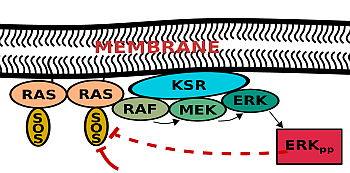
Signaling Processes in Biology

Transmembrane cellular signaling pathways are responsible for linking external stimuli and internal cellular actions. We work with minimal motif models for transmembrane cell signaling. The models assume signaling events taking place in spatially distributed nanoclusters regulated by a birth/death dynamics.
The combination of these spatio-temporal aspects can be modulated to provide a switch-like response behavior without invoking sophisticated modeling of the signaling process as a sequence of cascade reactions and ne-tuned parameters. Our results also show that the spatial organization of the signaling process and the fact that the distributed events take place in nanoclusters with a nite lifetime regulated by local production is sucient to obtain a robust and high-delity response.
Transmembrane cellular signaling pathways are responsible for linking external stimuli and internal cellular actions. The importance of certain ubiquitous motifs in signaling pathways (activation cascades and feedback loops) is well recognized. However, the role of the spatiotemporal aspects of signaling events is much less understood.
